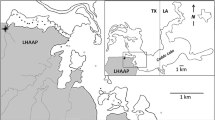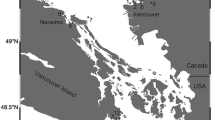Abstract
A partial life-cycle experiment was conducted to assess chronic effects of sediment-associated chlorpyrifos, an organophosphate pesticide, on a marine, benthic copepod population. The static-renewal experiment was initiated with 4 treatments including control, 13 replicates per treatment with one female (bearing first clutch of eggs) per replicate. No males were added because one fertilization is sufficient for several clutches. Once weekly, all replicate chamber contents (10-ml culture tubes with 1.5 ml of sediment and 5 ml of seawater) were sieved and enumerated to determine survival and fecundity. Surviving adult females were placed back into chambers with newly spiked sediments. This process was repeated for 7 weeks until all initial females were dead or reproduction had ceased for at least two weeks. Survival and fecundity data were then used to determine population dynamic parameters such as r (intrinsic rate of natural increase) for each treatment. Results revealed a chronic toxicity response with significant population effects (p<0.05) in all pesticide treatments versus the control; concentrations that represent 7–32% of the 96-hr LC50. The control treatment had an r value 26–52% higher than the pesticide treatments. This translated into a control population rate increase of up to twice that of pesticide treatments. In addition, significant reductions in weekly and total fecundity were found in all chlorpyrifos treatments. Based on these results, usage of population parameters with benthic copepods allows for an integrative measurement of population effects from chronic exposure to sediment-associated contaminants.
Similar content being viewed by others
References
Allan JD, Daniels RE (1982) Life table evaluation of chronic exposure of Eurytemora affinis (Copepoda) to kepone. Marine Biology 66:179–184
Ankley GT, Call DJ, Cox JS, Kahl MD, Hoke RA, and Kosian PA. (1994) Organic carbon partitioning as a basis for predicting the toxicity of chlorpyrifos in sediments. Environ Toxicol Chem 13:621–626
Bechmann, RK (1994) Use of life tables and LC50 tests to evaluate chronic and acute toxicity effects of copper on the marine copepod Tisbe furcata (Baird). Environ Toxicol Chem 13:1509–1517
Carey JR (1993) Applied demography for biologists with special emphasis on insects. Oxford University Press, NY, 206 pp
Chandler GT (1986) High density culture of meiobenthic harpacticoid copepods within a muddy sediment substrate. Can J Fish Aquat Sci 43:53–59
Chandler GT, Coull BC, Davis JC (1994) Sediment- and aqueous-phase fenvalerate effects on meiobenthos: implications for sediment quality criteria development. Mar Environ Res 37:313–327
Chandler GT, Green AS (1995) A 14-day harpacticoid copepod reproduction bioassay for laboratory and field contaminated muddy sediments. In: Ostrander GK (ed) New Techniques in Aquatic Toxicology. Lewis Publishers, pp 23–39.
Chandler GT, Scott GI (1991) Effects of sediment-bound endosulfan on survival, reproduction and larval settlement of meiobenthic polychaetes and copepods. Environ Toxicol Chem 10:375–382
Chapman PM, Morgan JD (1983) Sediment bioassays with oyster larvae. Bull Environ Contam Toxicol 31:438–444
Coull BC (1990) Are meiofauna food for higher trophic levels? Trans Am Micro Soc 109:233–246
Daniels RE, Allan JD (1981) Life table evaluation of chronic exposure to a pesticide. Can J Fish Aquat Sci 38:485–494
Day K, Kaushik NK (1987) An assessment of the chronic toxicity of the synthetic pyrethroid, fenvalerate, to Daphnia galeata mendotae, using life tables. Environ Pollut 44:13–26
DiToro DM, Zarba CS, Hansen DJ, Berry WJ, Swartz RC, Cowan CE, Pavlou SP, Allen HE, Thomas NA, Paquin PR (1991) Technical basis for establishing sediment quality criteria for nonionic organic chemicals using equilibrium partitioning. Environ Toxicol Chem 10:1541–1587
Dublin LI, Lotka AJ (1925) On the true rate of natural increase. J Am Stat Assos 20:305–339
Fernandez-Casalderrey A, Ferrando MD, Andreu-Moliner E (1993) Chronic toxicity of methylparathion to the rotifer Brachionus calyciflorus fed on Nannochloris oculata and Chlorella pyrenoidosa. Hydrobiologia 255/256:41–49
Ferrando MD, Janssen CR, Andreu E, Persoone G (1993) Ecotoxicological studies with the freshwater rotifer Brachionus calyciflorus. Hydrobiologia 255/256:33–40
Gee JM (1989) An ecological and economic review of meiofauna as food for fish. Zool J Lin Soc 96:243–261
Green AS, Chandler GT, Blood ER (1993) Aqueous-, pore-water-, and sediment-phase cadmium: Toxicity relationships for a meiobenthic copepod. Environ Toxicol Chem 12:1497–1506
Green AS, Chandler GT, Coull BC (1995) Age-specific survival analysis of an infaunal meiobenthic copepod, Amphiascus tenuiremis. Mar Ecol Prog Ser 129:107–112.
Green As, Chandler GT, Piegorsch WW (1996) Life-stage specific toxicity of sediment-associated chlorpyrifos to a marine, infaunal copepod. Environ Toxicol Chem (in press).
Hummon WD (1974) Effects of DDT on longevity and reproductive rate in Lepidodermella squammata (Gastrotricha, Chaetonotida). Am Midl Nat 92:327–339
Jensen S, Renberg L, Reutergardh L (1977) Residue analysis of sediment and sewage sludge for organochlorines in the presence of elemental sulfur. Anal Chem 49:316–318
Knuth ML, Heinis LJ (1992) Dissipation and persistence of chlorpyrifos within littoral enclosures. J Agric Food Chem 40:1257–1263
Landrum PF (1989) Bioavailability and toxicokinetics of polycyclic aromatic hydrocarbons sorbed to sediments for the amphipod Pontoporeia hoyi. Environ Sci Technol 23:588–595
Lotka AJ (1925) Elements of physical biology. Williams and Wilkins, Baltimore, MD
Marshall WK, Roberts JR (1978) Ecotoxicology of chlorpyrifos. Publication 16079. National Research Council of Canada, Ottawa, Ontario.
Munzinger A., Monicelli F (1992) Heavy metal co-tolerance in a chromium tolerant strain of Daphnia magna. Aquat Toxicol 23:203–216
Odenkirchen EW, Eisler R (1988) Chlorpyrifos hazard to fish, wildlife, and invertebrates: A synoptic review. U.S. Fish and Wildl Ser Resour Publ 85(1.13)
Pait AS, DeSouza AE, Farrow RG (1992) Agricultural pesticide use in coastal areas: a national summary. National Oceanic and Atmospheric Adminstration, Rockville, MD:Strategic Environmental Assessments Division, ORCA/NOS/NOAA. 112 pp
Pressat R (1985) The dictionary of demography. Bell and Bain, LTD, Glasgow
SAS Institute (1985) SAS® User's Guide: Statistics, Version 5 Edition. Cary, NC
Strawbridge S, Coull BC, Chandler GT (1992) Reproductive output of a meiobenthic copepod exposed to sediment-associated fenvalerate. Arch Environ Contam Toxicol 23:295–300
Swartz RC, Kemp PF, Schults DW, Ditsworth GR, Ozretich RJ (1989) Acute toxicity of sediment from Eagle Harbor, Washington, to the infaunal amphipod Phepoxynius abronius. Environ Toxicol Chem 8:215–222
U.S. Environmental Protection Agency (1986) Ambient water quality criteria for chlorpyrifos. EPA 440/5-86-005 Washington, DC
-- (1994) Methods for assessing the toxicity of sediment associated contaminants with estuarine and marine amphipods. EPA 600/R-94/025 Washington, DC
van Wijngaarden R, Leewangh P, Lucasesen WGH, Romijn K, Ronday R, van der Velde R, Willigenburg W (1993) Acute toxicity of chlorpyrifos to fish, a newt, and aquatic invertebrates. Bull Environ Contam Toxicol 51:716–723
Veith GD, Kiwus LM (1977) An exhaustive steam-distillation and solvent-extraction unit for pesticides and industrial chemicals. Bull Environ Contam Toxicol 17:631–636
Winner RW, Farrel MP (1976) Acute and chronic toxicity of copper to four species of Daphnia. J Fish Res Board Can 33:1685–1691
Woods RE, Coull BC (1992) Life history responses of Amphiascus tenuiremis (Copepoda, Harpacticoida) to mimicked predation. Mar Ecol Prog Ser 79:225–234
Author information
Authors and Affiliations
Rights and permissions
About this article
Cite this article
Green, A.S., Chandler, G.T. Life-table evaluation of sediment-associated chlorpyrifos chronic toxicity to the benthic copepod, Amphiascus tenuiremis . Arch. Environ. Contam. Toxicol. 31, 77–83 (1996). https://doi.org/10.1007/BF00203910
Received:
Revised:
Issue Date:
DOI: https://doi.org/10.1007/BF00203910




